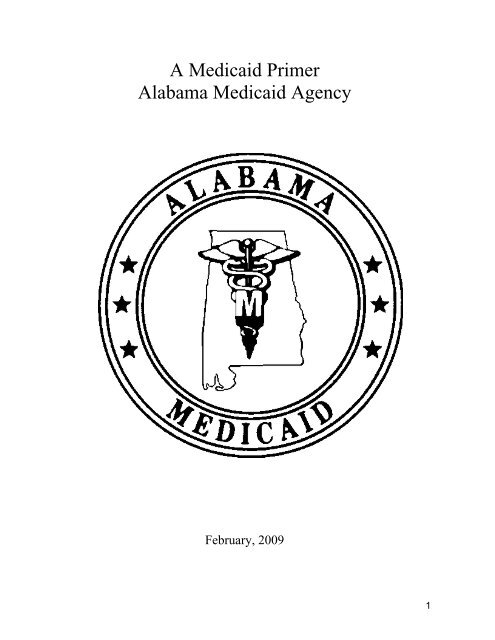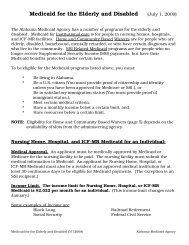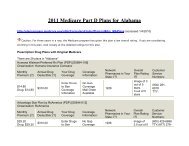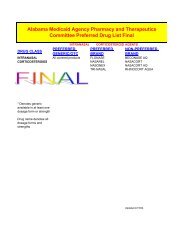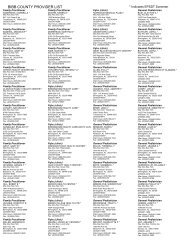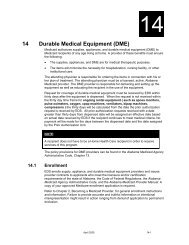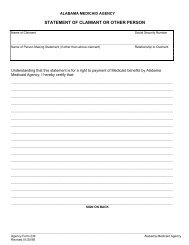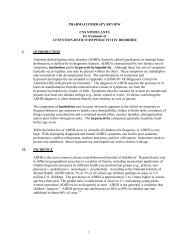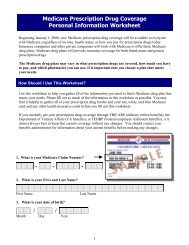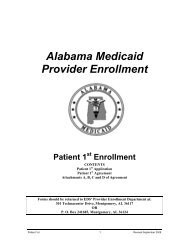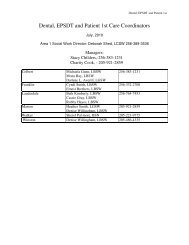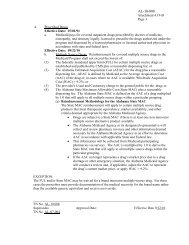A Medicaid Primer Alabama Medicaid Agency
A Medicaid Primer Alabama Medicaid Agency
A Medicaid Primer Alabama Medicaid Agency
Create successful ePaper yourself
Turn your PDF publications into a flip-book with our unique Google optimized e-Paper software.
A <strong>Medicaid</strong> <strong>Primer</strong><br />
<strong>Alabama</strong> <strong>Medicaid</strong> <strong>Agency</strong><br />
February, 2009<br />
1
A <strong>Medicaid</strong> Eligibility <strong>Primer</strong><br />
<strong>Alabama</strong> <strong>Medicaid</strong> <strong>Agency</strong><br />
1. What is <strong>Medicaid</strong>?<br />
Title XIX of the Social Security Act (SSA) is a program that provides medical assistance for<br />
certain individuals and families with low income and resources. The program, known as<br />
<strong>Medicaid</strong>, became law in 1965. <strong>Medicaid</strong> is the largest program providing medical and healthrelated<br />
services to <strong>Alabama</strong>'s poorest people.<br />
2. Who Determines Eligibility for <strong>Medicaid</strong> Benefits in <strong>Alabama</strong>?<br />
There are three agencies in <strong>Alabama</strong> that certify individuals for <strong>Medicaid</strong>. These agencies<br />
certify certain groups of individuals for <strong>Medicaid</strong> based on their circumstances.<br />
These agencies are:<br />
The Social Security Administration,<br />
The Department of Human Resources, and<br />
The <strong>Alabama</strong> <strong>Medicaid</strong> <strong>Agency</strong>.<br />
The Social Security Administration certifies individuals for the following programs: Low<br />
income individuals who are aged, blind, or disabled may qualify for cash assistance through the<br />
Supplemental Security Income (SSI) program. Individuals eligible for SSI are automatically<br />
eligible for <strong>Medicaid</strong>. You may hear someone say <strong>Alabama</strong> is a Section 1634 state. That<br />
means that we accept Social Security Administration's eligibility determination for this group.<br />
The Department of Human Resources certifies individuals for the following programs:<br />
Foster children and children who receive State or Federal Adoption Assistance.<br />
The <strong>Alabama</strong> <strong>Medicaid</strong> <strong>Agency</strong> certifies individuals for the following programs:<br />
Pregnant women and children under age 19. Pregnant women and children under age<br />
19 in families with income below certain limits. Applicants should contact their local<br />
SOBRA <strong>Medicaid</strong> eligibility worker located in Health Departments and some hospitals.<br />
NOTE: Some pregnant women receive pregnancy-related services only.<br />
Plan First Program. Women who are 19-55 years of age and whose income is below a<br />
certain limit. NOTE: These women receive family planning services only. You may<br />
call 1 (888) 737-2083 for more information.<br />
Breast and Cervical Cancer Program. Women under age 65 who have been screened<br />
through the Centers for Disease Control and Prevention’s National Breast & Cervical<br />
Cancer Early Detection Program and diagnosed with breast or cervical cancer may be<br />
eligible for this program. Call 1 (877) 252-3324.<br />
Nursing home and institutional level of care. <strong>Medicaid</strong> District Offices certify<br />
eligibility for nursing home care, home and community based waiver services (elderly<br />
and disabled, SAIL, HIV, Living at Home, Technology Assisted, and mentally retarded,<br />
and post extended hospital days.<br />
SSI related groups. Widow/Widower, Disabled Adult Child, Retroactive SSI,<br />
Continuous (PICKLE), Grandfathered Children.<br />
Medicare related groups. (Qualified Medicare Beneficiary, Specified Low-Income<br />
Medicare Beneficiaries, Qualifying Income groups, and Qualified Disabled Working<br />
Individuals).<br />
Emergency services for aliens- certain aliens may receive emergency services.<br />
2
<strong>Medicaid</strong> for Low Income Families Program-Families with children under the age of<br />
19 who qualify for MLIF in the household may apply.<br />
3. Who Receives Mandatory <strong>Medicaid</strong> Benefits?<br />
During FY 2008, 920,937 individuals were eligible for <strong>Medicaid</strong> benefits.<br />
States have some discretion in determining which groups their <strong>Medicaid</strong> programs will cover<br />
and the financial criteria for <strong>Medicaid</strong> eligibility. To be eligible for federal funds, states are<br />
required to provide <strong>Medicaid</strong> coverage for most people who get federally assisted income<br />
maintenance payments, as well as for related groups not getting cash payments. Some examples<br />
of the mandatory <strong>Medicaid</strong> eligibility groups include the following:<br />
Limited income families with children, as described in Section 1931 of the Social<br />
Security Act, who meet the eligibility requirements in the State's AFDC plan in effect<br />
on July 16, 1996. This group is referred to as MLIF.<br />
Supplemental Security Income (SSI) recipients (or in States using more restrictive<br />
criteria--aged, blind, and disabled individuals who meet criteria which are more<br />
restrictive than those of the SSI program and which were in place in the State's<br />
approved <strong>Medicaid</strong> plan as of January 1, 1972);<br />
<br />
Infants born to <strong>Medicaid</strong>-eligible pregnant women. <strong>Medicaid</strong> eligibility must continue<br />
throughout the first year of life so long as the infant remains in the mother's household<br />
and she remains eligible, or would be eligible if she were still pregnant;<br />
Children under age 6 and pregnant women whose family income is at or below 133<br />
percent of the Federal poverty level and children under age 19 up to 100% of poverty.<br />
(The minimum mandatory income level for pregnant women and infants in certain<br />
States may be higher than 133%, if as of certain dates the State had established a higher<br />
percentage for covering those groups.) States are required to extend <strong>Medicaid</strong><br />
eligibility until age 19 to all children born after September 30, 1983 (or such earlier date<br />
as the State may choose) in families with incomes at or below the federal poverty level.<br />
Once eligibility is established, pregnant women remain eligible for <strong>Medicaid</strong> through<br />
the end of the calendar month in which the 60th day after the end of the pregnancy falls,<br />
regardless of any change in family income. States are not required to have a resource<br />
test for these poverty level related groups. However, any resource test imposed can be<br />
no more restrictive than that of the AFDC program for infants and children and the SSI<br />
program for pregnant women;<br />
<br />
<br />
<br />
Recipients of adoption assistance and foster care under Title IV-E of the Social Security<br />
Act;<br />
Certain people with Medicare; and<br />
Special protected groups who may keep <strong>Medicaid</strong> for a period of time. Some examples<br />
include persons who lose SSI payments due to earnings from work or increased Social<br />
Security benefits; and families who are provided 6 to 12 months of <strong>Medicaid</strong> coverage<br />
following loss of eligibility under Section 1931 (MLIF) due to earnings, or 4 months of<br />
<strong>Medicaid</strong> coverage following loss of eligibility under Section 1931 due to an increase in<br />
child or spousal support.<br />
3
4. Which Optional Beneficiary Groups May Receive <strong>Medicaid</strong> Benefits?<br />
States also have the option to provide <strong>Medicaid</strong> coverage for other "categorically needy"<br />
groups. These optional groups share characteristics of the mandatory groups, but the eligibility<br />
criteria are somewhat more liberally defined. Examples of the optional groups that States may<br />
cover as categorically needy (and for which they will get federal matching funds) under the<br />
<strong>Medicaid</strong> program include the following:<br />
infants up to age one and pregnant women not covered under the mandatory rules<br />
whose family income is below 185 percent of the Federal poverty level (the percentage<br />
to be set by each State); (<strong>Alabama</strong> does not utilize this option)<br />
<br />
<br />
<br />
<br />
<br />
<br />
<br />
<br />
optional targeted low income children; (AL does not utilize this option)<br />
certain aged, blind, or disabled adults who have incomes above those requiring<br />
mandatory coverage, but below the Federal poverty level; (AL does not utilize this<br />
option)<br />
children under age 21 who meet income and resources requirements for AFDC, but who<br />
otherwise are not eligible for AFDC; (AL utilizes this option for DHR state foster<br />
children and DYS children)<br />
institutionalized individuals with limited income and resources; (AL utilizes this<br />
option and covers up to 300% of the SSI income level)<br />
persons who would be eligible if institutionalized but are receiving care under home and<br />
community-based services waivers; (AL utilizes this option for the MR, E&D, SAIL,<br />
and other waivers)<br />
Recipients of State supplementary payments; <strong>Alabama</strong> does not utilize this option.<br />
However, <strong>Alabama</strong> covers certain individuals who once received SSI and supplemental<br />
payments.<br />
TB-infected persons who would be financially eligible for <strong>Medicaid</strong> at the SSI level<br />
(only for TB-related ambulatory services and TB drugs) (<strong>Alabama</strong> does not utilize this<br />
option);<br />
low-income, uninsured women screened and diagnosed through a Center's for Disease<br />
Control (CDC) Breast and Cervical Cancer Early Detection Program (NBCCEDP) and<br />
determined to be in need of treatment for breast or cervical cancer. (AL utilizes this<br />
federal option which is now a state law)<br />
States may use more liberal income and resources methodologies to determine <strong>Medicaid</strong><br />
eligibility for certain AFDC-related and aged, blind, and disabled individuals under Sections<br />
1902(r)(2) and 1931 of the Social Security Act. For some groups, the more liberal income<br />
methodologies cannot result in the individual’s income exceeding the limits prescribed for<br />
Federal matching.<br />
5. Does <strong>Medicaid</strong> Cover All Low-Income People?<br />
<strong>Medicaid</strong> does not provide medical assistance for all poor persons. Even under the broadest<br />
provisions of the Federal statute (except for emergency services for certain persons), the<br />
<strong>Medicaid</strong> program does not provide health care services, even for very poor persons, unless<br />
they are in one of the designated mandatory groups or in an optional group the state has elected<br />
to cover.<br />
4
Low income is only one test for <strong>Medicaid</strong> eligibility; assets and resources are also tested<br />
against established limits in most programs. Categorically needy persons who are eligible for<br />
<strong>Medicaid</strong> may or may not also receive cash assistance from the TANF program or from the SSI<br />
program. Additionally, states define in their State Plan, the amount, duration, and scope of<br />
coverage. State <strong>Medicaid</strong> Agencies may place appropriate limits on a service based on such<br />
criteria as medical necessity or on utilization control procedures. A State Plan must provide that<br />
the services available to any individual in the categorically needy group are equal in amount,<br />
duration, and scope for all recipients within the group.<br />
6. What is the <strong>Medicaid</strong> - Medicare Relationship?<br />
The Medicare program (Title XVIII of the Social Security Act) provides hospital insurance<br />
(HI), also known as Part A coverage, and supplementary medical insurance (SMI), also known<br />
as Part B coverage. Coverage for HI is automatic for persons aged 65 and older (and for certain<br />
disabled persons) who have insured status under Social Security or Railroad Retirement.<br />
Coverage for HI may be purchased by individuals who do not have insured status through the<br />
payment of monthly Part A premiums. Coverage for SMI also requires payment of monthly<br />
premiums. Medicare beneficiaries who have low income and limited resources may receive<br />
help paying for their out-of-pocket medical expenses from their State <strong>Medicaid</strong> program. These<br />
"dual eligibles" are entitled to Medicare and are eligible for some type of <strong>Medicaid</strong> benefit.<br />
For persons with full <strong>Medicaid</strong> coverage, the <strong>Medicaid</strong> program supplements Medicare<br />
coverage by providing services and supplies that are available under their State's <strong>Medicaid</strong><br />
program. Services that are covered by both programs will be paid first by Medicare and the<br />
difference by <strong>Medicaid</strong>, up to the State's payment limit. <strong>Medicaid</strong> also covers additional<br />
services (e.g., nursing facility care beyond the 100-day limit covered by Medicare, prescription<br />
drugs, eyeglasses, and hearing aids).<br />
Limited <strong>Medicaid</strong> benefits are also available to pay for out-of-pocket Medicare cost-sharing<br />
expenses for certain other Medicare beneficiaries. The <strong>Alabama</strong> <strong>Medicaid</strong> program will assume<br />
their Medicare payment liability if they qualify. Qualified Medicare Beneficiaries (QMBs),<br />
with income at or below 100% of the annual Federal poverty level (FPL), do not have to pay<br />
their monthly Medicare premiums, deductibles, and coinsurance. <strong>Alabama</strong> dropped the<br />
resource/assets test for QMBs. Specified Low-Income Medicare Beneficiaries (SLMBs), with<br />
resources at or below twice the standard allowed under the SSI program and income exceeding<br />
the QMB level, but less than 120% of the FPL, do not have to pay the monthly Medicare Part B<br />
premiums. Qualifying Individuals (QIs), who are not otherwise eligible for full <strong>Medicaid</strong><br />
benefits and with resources at or below twice the standard allowed under the SSI program, will<br />
get help with their monthly Medicare Part B premiums, depending upon their income. Each<br />
state has a limited number of slots for QI's.<br />
Individuals who were receiving Medicare due to disability, but have lost entitlement to<br />
Medicare benefits because they returned to work, may purchase Part A of Medicare. If the<br />
individual has income below 200% of the FPL and resources at or below twice the standard<br />
allowed under the SSI program, and they are not otherwise eligible for <strong>Medicaid</strong> benefits, they<br />
may qualify to have <strong>Medicaid</strong> pay their monthly Medicare Part A premiums as Qualified<br />
Disabled and Working Individuals (QDWIs).<br />
5
7. How Much Does <strong>Medicaid</strong> Pay for the Medicare Premium Buy-In<br />
Program?<br />
Through the Buy-In Program, <strong>Medicaid</strong> pays Medicare Part A and B premiums for eligible<br />
<strong>Medicaid</strong> recipients. In fiscal year 2008, <strong>Medicaid</strong> paid over $8.4 million in Part A premiums<br />
for approximately 1,839 individuals; and over $218 million in Part B premiums for<br />
approximately 214,762 individuals. For recipients eligible for the Qualified Medicare<br />
Beneficiary (QMB) Program, <strong>Medicaid</strong> may also cover their Medicare co-insurance and<br />
deductibles. For more information about the Buy In program, contact Wanda Wright at (334)<br />
242-5281.<br />
8. Who are <strong>Alabama</strong>'s <strong>Medicaid</strong> Providers?<br />
Any physician or dentist who is licensed by their State License Boards may become a <strong>Medicaid</strong><br />
provider. <strong>Alabama</strong> <strong>Medicaid</strong>'s fiscal agent, EDS, processes applications. Primary care<br />
physicians provide medical homes for patients through the Patient 1 st program and most<br />
primary care physicians in <strong>Alabama</strong> are enrolled in <strong>Medicaid</strong>. Physicians taking part in the<br />
<strong>Medicaid</strong> program are designated as serving in rural or urban communities. Each year, more<br />
than 600,000 <strong>Medicaid</strong> patients receive care from a physician and that care is provided by<br />
5,000 physicians, 75% of whom practice in urban areas.<br />
<strong>Alabama</strong> dentists have become more involved in the <strong>Medicaid</strong> program in the last few years<br />
with renewed interest in being available to <strong>Medicaid</strong> children. As of October 2008, 813<br />
dentists were enrolled in the program. The <strong>Agency</strong> expects enrollment to continue to expand.<br />
Additionally, the number of counties with only one or no dentist enrolled has decreased from<br />
11 to 8.<br />
9. How Does <strong>Medicaid</strong> Watch for Fraud?<br />
The <strong>Medicaid</strong> Alliance for Program Safeguards is committed to fighting fraud and abuse,<br />
which divert dollars that should be spent to safeguard the health and welfare of <strong>Medicaid</strong><br />
clients. States are primarily responsible for policing fraud in the <strong>Medicaid</strong> program. Fraud<br />
schemes often cross State lines. Through the development of the <strong>Medicaid</strong> Fraud Statutes<br />
website and leadership, the <strong>Medicaid</strong> Alliance for Program Safeguards works to build<br />
partnerships and cooperative efforts among State <strong>Medicaid</strong> programs, State Program Integrity<br />
Units, State Quality Control Units, State Surveillance and Utilization Review Units, State<br />
<strong>Medicaid</strong> Fraud Control Units, the Department of Health and Human Services' Office of<br />
Inspector General, the Federal Bureau of Investigation, and the Department of Justice, among<br />
other partners.<br />
We are all partners, however, in fighting fraud and abuse in <strong>Medicaid</strong>. Suspected beneficiary or<br />
provider fraud may be reported toll free at (800) 362-1504.<br />
10. Who Does <strong>Medicaid</strong> Cover?<br />
<strong>Medicaid</strong> covers over 930,000 individuals. Individuals generally become eligible through one<br />
of the federally mandated programs and sometimes through a federally optional program that<br />
<strong>Alabama</strong> has opted to cover.<br />
This is a very condensed summary of the different eligibility programs covered by the <strong>Alabama</strong><br />
<strong>Medicaid</strong> program:<br />
6
ELIGIBILITY GROUPS SUMMARY-ALABAMA MEDICAID AGENCY<br />
Eligibility Group Includes Federal Requirement Meets or Exceeds or Optional Program<br />
NURSING HOME/<br />
INSTITU-<br />
TIONALIZED<br />
The 2009 nursing home<br />
income limit is $2,022<br />
SSI-RELATED<br />
MEDICARE-<br />
RELATED<br />
PREGNANT<br />
WOMEN AND<br />
CHILDREN<br />
MEDICAID FOR<br />
LOW-INCOME<br />
FAMILIES<br />
OPTIONAL<br />
FEDERAL<br />
CATEGORIES<br />
ALL OTHER<br />
Nursing home; extended<br />
hospital awaiting nursing<br />
home placement; facilities<br />
for the mentally ill or<br />
retarded<br />
Widow/Widower; Disabled<br />
Adult Child;<br />
Grandfathered Cases;<br />
continuous (PICKLE);<br />
retroactive SSI; children of<br />
SSI mothers<br />
Qualified Medicare<br />
Beneficiaries; Specified<br />
Low Income Medicare<br />
Beneficiaries; Qualifying<br />
Income Individuals, and<br />
Qualified Disabled<br />
Working Individuals<br />
Pregnant women and<br />
children under the age of<br />
19<br />
Low income families with<br />
children<br />
Breast and Cervical<br />
Cancer Program; State of<br />
AL Independent Living<br />
(SAIL) waiver; MR<br />
waiver; E&D waiver;<br />
OBRA waiver; Plan First<br />
waiver, Technology<br />
Assisted waiver for Adults,<br />
HIV/AIDS waiver<br />
Emergency Services for<br />
Aliens; Department of<br />
Youth Services Children;<br />
DHR Foster Children;<br />
Adopted Children;<br />
Refugees etc.<br />
Income guidelines set annually<br />
at federal level.<br />
2009 SSI income limits at $694<br />
for individual and $1,031 for<br />
couple.<br />
FPL as of 02/2009<br />
QMB-income below 100% FPL<br />
($923 – individual; $1,235 -<br />
couple);<br />
SLMB-income between 100%-<br />
120% FPL ($923.01-$1,103.00<br />
– individual; $1,235.01 -<br />
$1,477.00 - couple);<br />
QI-1-between 120%-135%<br />
($1,103.01-$1,239.00 –<br />
individual; $1,477.01 -<br />
$1,660.00 - couple)<br />
QDWI- income under<br />
$1,825.00 – individual;<br />
$2,449.00 – couple<br />
Covers children under age 6<br />
and pregnant women with<br />
family income below 133% of<br />
the FPL; and children age six<br />
but under age 19 (6-18) up to<br />
100% of the FPL.<br />
Section 1931 of the SSA who<br />
meet eligibility requirements in<br />
the State’s AFDC plan in effect<br />
on July 16, 1996.<br />
AL utilizes option 1915 (c) of<br />
the SSA to cover individuals<br />
who meet the institutional level<br />
of care but desire to remain at<br />
home and receive care under<br />
the SAIL waiver, MR waiver,<br />
E&D waiver, Technology<br />
Assisted waiver for Adults, and<br />
HIV/AIDS waiver.<br />
Title IV-E covers adoption and<br />
foster care<br />
Exceeds. AL covers institutionalized individuals with<br />
income up to 300% of the SSI income level. This option<br />
is known as the 300% of SSI rule. Resources are within<br />
the SSI resource limit. As required by law, AL covers<br />
individuals who establish a Qualifying Income Trust.<br />
Meets minimum federal requirements. AL does not<br />
utilize the option to cover optional supplementary<br />
payment groups. AL does not utilize the OBRA 86<br />
option for aged and disabled persons with incomes up<br />
to 100% of the FPL.<br />
Meets minimum income requirements. However, AL<br />
applies less restrictive methodology. Fluctuating<br />
income may be averaged for the past six months and<br />
projected for 12 months; in-kind support and<br />
maintenance is not counted as income; interest and<br />
dividend income is not counted in determining eligibility;<br />
and all resources are disregarded.<br />
Meets minimum income requirements for pregnant<br />
women and children under age 19. Infants born to<br />
<strong>Medicaid</strong> eligible pregnant women have coverage<br />
through the first year of life. AL does not utilize option<br />
to cover family income up to 185% of the FPL. AL does<br />
not impose optional assets/ resource test.<br />
Meets federal income requirements but is well below<br />
the national average. Covers only the poorest of the<br />
poor (11.5% of FPL).<br />
The federal optional Breast and Cervical Cancer Option<br />
was passed into AL law as a mandated service. The<br />
Home and Community Based Waivers are optional<br />
services that provide a cost savings to the agency.<br />
Otherwise these individuals would be in more costly<br />
nursing home settings. The Plan First optional waiver<br />
continues to be a cost effective waiver by reducing<br />
costs for unplanned pregnancies.<br />
AL meets requirements for aliens ER services. AL does<br />
not utilize option to cover TB infected individuals. AL<br />
utilizes option to cover certain children (state foster<br />
children) up to age 21 who meet income and resource<br />
requirements for AFDC and have special medical<br />
needs. Refugee services are 100% reimbursed by the<br />
refugee resettlement program.<br />
7
11. Please Summarize the Eligibility Policy for the Elderly and Disabled.<br />
Cash Assistance Group<br />
<strong>Alabama</strong> is a Section 1634 state. We accept the Social Security<br />
Administration's eligibility determination.<br />
State Supplement Group (Optional Group)<br />
Many states supplement the basic SSI cash assistance with state supplementary<br />
payments (SSP) to certain SSI beneficiaries (who receive the SSI payment plus<br />
the SSP) and people with incomes too high to qualify for SSI (only receive the<br />
SSP). Financed solely with state money, these payment amounts vary widely<br />
from state to state. States can opt to make anyone receiving an SSP<br />
automatically eligible for <strong>Medicaid</strong>; at least thirty-five states have elected this<br />
option. States may also apply less restrictive methodologies to this group when<br />
determining how to count income and resources.<br />
Individuals receiving State Supplemental payments (SSP) are automatically<br />
eligible to receive <strong>Medicaid</strong> in <strong>Alabama</strong>.<br />
Dual Eligible Group<br />
<br />
Described in the <strong>Medicaid</strong>-Medicare Relationship, question 6.<br />
<strong>Alabama</strong> applies the following less restrictive income methodologies for this<br />
group: Fluctuating income may be averaged for the past six months and<br />
projected for twelve months; in-kind support and maintenance (ISM) is not<br />
counted as income; interest income is not counted in determining eligibility;<br />
dividend income is not counted in determining eligibility. All resources are<br />
disregarded (no asset test).<br />
Institutionalized Individuals (Optional Expansion)<br />
Congress gave states the option to use the special income rule to provide <strong>Medicaid</strong><br />
to persons in institutions who have too much income to qualify for SSI benefits, but<br />
not enough income to cover their expensive long-term care. Under the special<br />
income rule, also known as the 300% of SSI rule, states may set a special income<br />
standard up to 300% of the maximum SSI benefit. This applies to gross income<br />
only—that is, there are no exclusions or deductions. Resource standards are<br />
generally the same as those in the SSI program. The special income rule was<br />
originally limited to persons in institutions, but now states may elect to apply it to<br />
those receiving services under home and community-based care (HCBS) waivers, as<br />
well. Both groups—persons in institutions and persons under HCBS waivers—are<br />
required to incur a post-eligibility cost-sharing burden under this eligibility<br />
category. States that use the special income rule, but do not offer a medically needy<br />
group for aged, blind, and disabled persons must allow the use of Qualifying<br />
Income Trusts (QITs) also known as Miller Trusts—a trust designed to hold and<br />
apportion the individual’s excess income according to need and for the express<br />
purpose of becoming eligible for <strong>Medicaid</strong>, subject to <strong>Medicaid</strong> estate recovery.<br />
States must allow nursing facility residents to keep a limited amount (at least $30)<br />
of their income as a personal needs allowance. Some states have opted to increase<br />
this amount slightly. Each state also has spousal impoverishment protections in<br />
place to ensure that when one spouse is institutionalized for at least 30 days, the<br />
other spouse—the community spouse—does not lose all income and resources,<br />
8
thereby becoming impoverished and needing public assistance. The community<br />
spouse’s income is not considered available to the institutionalized spouse.<br />
To protect resources, the couple’s resources (excluding home, household goods, one<br />
automobile, and burial funds) are combined and then halved to determine the<br />
spousal share. The spousal share is then compared to the state’s community spouse<br />
protected resource amount (CSRA). The amount actually protected for the<br />
community spouse is the greater of either the spousal share or the CSRA. By federal<br />
law, the CSRA is subject to a minimum (at and below which the entire amount is<br />
protected) and a maximum. When setting its CSRA, the state may exceed the<br />
federally prescribed minimum, but may not exceed the federal maximum.<br />
<strong>Alabama</strong> uses the special income standard for institutionalized individuals.<br />
The special income standard is at 300% of SSI income for a month.<br />
The monthly personal needs allowance for nursing facility residents is $30 per<br />
individual in nursing home. (Veterans or widows of veterans with no dependents<br />
may receive $90.00 VA benefit payment while in the nursing home for personal<br />
needs allowance.)<br />
<strong>Alabama</strong> uses an amount in the middle as its minimum community spouse<br />
protected resource standard. Our minimum community spouse protected<br />
resource standard is $25,000. We allow the federal maximum community<br />
spouse protected resource of $109,560.<br />
Home and Community-Based Waiver Services (Optional Group)<br />
States may apply for §1915(c) home and community-based care waivers that allow<br />
them to extend <strong>Medicaid</strong> eligibility to those at risk of institutionalization who wish<br />
to remain in a community setting. Under this waiver authority, a state may provide a<br />
wider range of long-term care services than is generally allowed under the state’s<br />
<strong>Medicaid</strong> program, including non-medical services such as minor home<br />
modifications like ramps or special safety devices. Often states operate several<br />
HCBS waivers targeted to various populations.<br />
Applicants must still qualify for <strong>Medicaid</strong> under one of the <strong>Medicaid</strong> eligibility<br />
groups and must require a nursing home level of care. However, many states link<br />
financial eligibility for their HCBS waivers to a percentage of the maximum<br />
monthly SSI payment (often via the special income rule), a percentage of the federal<br />
poverty level, or their medically needy income level.<br />
States may apply spousal impoverishment rules to HCBS waiver participants,<br />
similar to the protections guaranteed to institutionalized persons.<br />
States may choose to allow spend-down to HCBS waiver eligibility levels. If a state<br />
uses the special income rule and does not allow spend-down to HCBS eligibility<br />
levels, it may allow Qualifying Income Trusts (Miller Trusts) in determining<br />
eligibility for HCBS waivers.<br />
Because waiver participants must cover all of their living expenses themselves,<br />
states that extend the special income rule to HCBS often allow them a significant<br />
personal needs allowance. In addition, states may offer a monthly maintenance<br />
needs allowance for a spouse.<br />
<br />
<br />
<strong>Alabama</strong> uses different income standards for its HCBS waivers.<br />
Income eligibility for HCBS waivers is tied to:<br />
9
300% federal benefit rate for SAIL, HIV/AIDS, TA, MR and the<br />
Elderly and Disabled waivers.<br />
<strong>Alabama</strong> does not allow spend-down to HCBS waiver eligibility levels.<br />
<strong>Alabama</strong> does not allow Qualifying Income Trusts (Miller Trusts) in<br />
determining eligibility for HCBS waivers.<br />
<strong>Alabama</strong>'s protected monthly income for individuals receiving HCBS varies by<br />
waiver: The SAIL, HIV/AIDS, TA, MR and the Elderly and Disabled waivers<br />
protect 300% of the federal benefit rate.<br />
<strong>Alabama</strong>'s monthly maintenance needs allowance for a spouse (other than<br />
spousal impoverishment rules) is none.<br />
In, <strong>Alabama</strong>, none of the waiver participants incur a post-eligibility cost-sharing<br />
burden or liability.<br />
12. Please Summarize the Eligibility Policy for the Women's and<br />
Children's Groups.<br />
Pregnant Women and Children (Mandatory Group)<br />
In 1986, Congress enacted legislation allowing states, for the first time, to<br />
expand eligibility for <strong>Medicaid</strong> without expanding eligibility for Aid to Families<br />
with Dependent Children (AFDC). This federal law was called the Sixth<br />
Omnibus Budget Reconciliation Act (SOBRA). Subsequently, other federal laws<br />
have been enacted mandating coverage to even more children and pregnant<br />
women and mandating the outstationing of social workers in disproportionate<br />
share hospitals and health centers for easy access to the program by potential<br />
clients. In 1997 Congress passed the Balanced Budget Act. This legislation<br />
created the Title XXI Child Health Insurance Program (CHIP). The same<br />
legislation allowed for Continuous <strong>Medicaid</strong> Eligibility for all children<br />
determined eligible April 1, 1998 or thereafter.<br />
In July 1988, <strong>Alabama</strong> enacted this legislation to provide <strong>Medicaid</strong> coverage<br />
to pregnant women and children with income at or below the required<br />
Federal Poverty Level.<br />
<strong>Alabama</strong> has 180 SOBRA workers outstationed in hospitals, health<br />
department clinics and other health centers.<br />
<strong>Alabama</strong> was the first state in the nation to implement CHIP through a<br />
<strong>Medicaid</strong> expansion on February 1, 1998.<br />
Pregnant women and children under age six must have family income at or<br />
below 133% of the federal poverty level<br />
Children age six to 19 must have family income at or below 100% of the federal<br />
poverty level<br />
Family assets are not counted for eligibility.<br />
Parental income is not counted for pregnant women who only desire to receive<br />
pregnancy related services<br />
Pregnant women, once determined eligible, remain eligible through sixty days<br />
post-partum<br />
10
Children born to <strong>Medicaid</strong> eligible pregnant women remain eligible for one year<br />
without separate application or verification<br />
Children under age 19, once determined eligible, remain continuously eligible<br />
for 12 months as long as they reside in the state.<br />
Pregnant women may be eligible to receive full <strong>Medicaid</strong> services through their<br />
sixty days post-partum if they meet <strong>Medicaid</strong> for Low Income Families income<br />
standards<br />
Income for a child in the home is not counted toward the eligibility of a pregnant<br />
woman or another child<br />
Income of a step-parent is not counted toward the eligibility of a child in the<br />
home<br />
Related or non-related caretakers may apply for a child<br />
Income of caretakers other than legal parents is not counted toward the<br />
eligibility of a child<br />
Application may be made in-person, by mail or on-line, and you may apply in<br />
any county<br />
<strong>Medicaid</strong> for Low Income Families Qualified Pregnant Women ((MLIF-Q)<br />
Certain pregnant women may qualify for full <strong>Medicaid</strong> coverage. If the claimant<br />
meets <strong>Medicaid</strong> for Low Income Families (MLIF) program requirements, she may<br />
choose to receive full <strong>Medicaid</strong> coverage instead of coverage for only pregnancy<br />
related services normally covered through the SOBRA program. In addition to<br />
SOBRA requirements, the claimant must meet the following requirements in order<br />
to qualify for full coverage:<br />
<br />
<br />
Gross monthly income must fall below <strong>Medicaid</strong> for Low Income Families<br />
income limits.<br />
If the pregnant claimant is under age 18 and is living in the home with her<br />
parent(s), the amount of deemed income must not exceed MLIF income limits.<br />
Plan First (Optional Waiver for Family Planning Services)<br />
The Plan First waiver extends <strong>Medicaid</strong> eligibility for family planning services to all<br />
women of childbearing age (ages 19 through 55) with incomes at or below 133% of<br />
the federal poverty level that would not otherwise qualify for <strong>Medicaid</strong> coverage.<br />
Under existing <strong>Medicaid</strong> Programs, adult women and teenage girls are covered for<br />
family planning services along with all other <strong>Medicaid</strong> services through the<br />
<strong>Medicaid</strong> for Low Income Families (MLIF) program, the SSI program or other<br />
categorical eligibility groups. Women who receive <strong>Medicaid</strong> coverage for<br />
pregnancy and delivery services through the SOBRA program are covered for<br />
family planning services until the end of the month in which the 60th postpartum<br />
day falls. Women served through Plan First will be able to take advantage of all<br />
family planning services that are offered through the <strong>Alabama</strong> <strong>Medicaid</strong> <strong>Agency</strong><br />
and will be able to receive these services directly through any qualified provider<br />
enrolled in the Plan First Program.<br />
Breast and Cervical Cancer Program (Optional Eligibility Group)<br />
The Breast and Cervical Cancer Prevention and Treatment Act of 2000 (BCCPTA)<br />
allows states to provide full <strong>Medicaid</strong> benefits to uninsured women under age 65 who<br />
are identified through the Centers for Disease Control and Prevention's National Breast<br />
11
and Cervical Cancer Early Detection Program (NBCCEDP) and are in need of treatment<br />
for breast or cervical cancer. This includes pre-cancerous conditions of the breast or<br />
cervix and early stage cancer.<br />
The <strong>Alabama</strong> Legislature passed the Breast and Cervical Cancer Prevention and<br />
Treatment Act of 2000, requiring the federally optional program to be implemented<br />
in <strong>Alabama</strong>. Effective October 1, 2001, the <strong>Alabama</strong> <strong>Medicaid</strong> <strong>Agency</strong> extended<br />
full coverage <strong>Medicaid</strong> eligibility to females under age 65 who have been screened<br />
by the <strong>Alabama</strong> Breast and Cervical Cancer Early Detection Program (ABCCEDP)<br />
and been found to need treatment for breast or cervical cancer. In <strong>Alabama</strong>, the<br />
CDC funded program is administered through the <strong>Alabama</strong> Department of Public<br />
Health.<br />
13. What are the Mandatory Services for Categorically Needy <strong>Medicaid</strong><br />
Beneficiaries?<br />
Mandatory Services are defined at 42 CFR 440.210. References below are from 42 CFR or the<br />
SSA. Mandatory services are:<br />
Inpatient hospital services other than services in an institution of mental disease 440.10<br />
Outpatient hospital services 440.20(a)<br />
Federally Qualified Health Centers 1905 (a)(2)(C) of the SSA<br />
Rural Health Clinic services 440.20(b)<br />
Other laboratory and X-ray services 440.30<br />
Nursing facility services for individuals age 21 or older (other than services in an institution for<br />
mental disease) 440.40(a)<br />
Early Periodic Screening, Diagnostic, and Treatment (EPSDT) 440.40(b)<br />
Family planning services and supplies 440.40(c)<br />
Physician services 440.50(a)<br />
Medical and surgical services of a dentist that if provided by a physician would be considered<br />
physician's services 440.50(b)<br />
Home health services including nursing, aide, and therapy services provided by a Home Health<br />
<strong>Agency</strong> in the home; and medical supplies, equipment and appliances suitable for in-home use<br />
440.70<br />
Nurse midwife services 440.165<br />
Nurse practitioner services 440.166<br />
Pregnancy related services including postpartum 440.210<br />
14. Which Services are Optional for Categorically Needy <strong>Medicaid</strong><br />
Beneficiaries?<br />
*Clinic services-preventive, diagnostic, therapeutic, rehabilitative, or palliative services that are<br />
furnished by a facility that is not part of a hospital 440.90<br />
Critical Access Hospital (CAH) services 440.170(g)<br />
Dental services-diagnostic, preventive and corrective procedures 440.100<br />
Dentures 440.120(b)<br />
*Diagnostic, screening, preventive, and rehabilitative services 440.130<br />
Emergency Hospital services even if the hospital does not meet the conditions of participation<br />
for Medicare or the definitions of 440.170(e)<br />
12
*End Stage Renal Disease 441.40<br />
*Eyeglasses 440.120(d)<br />
*Home and Community Based services 440.180/440.181<br />
*Hospice services 1905(o) of the SSA<br />
*ICF-MR facility services 440.150<br />
*Inpatient hospital services, nursing facility services, or intermediate care facility services for<br />
individuals age 65 or older in institutions for mental disease 440.140<br />
Inpatient psychiatric services under age 21 440.160<br />
Medical or other remedial care provided by licensed practitioners other than physicians within<br />
the scope of practice defined by State Law such as chiropractic services 440.60<br />
Occupational therapy 440.110(b)<br />
*Organ transplants 441.35<br />
Personal care services 440.167<br />
Physical therapy 440.110(a)<br />
*Prescribed drugs 440.120(a)<br />
*Primary care case management services 440.168<br />
Private duty nursing services 440.80<br />
Prosthetic devices 440.120(c)<br />
Respiratory care for ventilator dependent individuals 440.185<br />
Services for individuals with speech, hearing and language disorders 440.110(c)<br />
Skilled nursing facilities for individuals under age 21 440.170<br />
*Targeted Case Management services 1905(a)(19) or 1915(g) of the Act<br />
*Transportation 440.170<br />
*Indicates the optional services covered by <strong>Alabama</strong> <strong>Medicaid</strong> for adults under the State Plan.<br />
QMBs receive additional coverage if Medicare makes payment.<br />
15. How is <strong>Medicaid</strong> Funded?<br />
The Federal and State governments jointly fund <strong>Medicaid</strong>. To be eligible for federal funds,<br />
states are required to provide <strong>Medicaid</strong> coverage for mandated coverage groups.<br />
The FY 2009 approved budget is $4.5 billion. This includes the state and federal share.<br />
<strong>Alabama</strong> <strong>Medicaid</strong> has one of the lowest administrative costs in the nation at 3 percent.<br />
<strong>Medicaid</strong> strives to place every possible dollar into use for direct medical services to<br />
beneficiaries thereby decreasing administrative costs associated with salaries, overhead and<br />
activities such as outreach. <strong>Medicaid</strong> outreach activities are often funded through grants<br />
<strong>Medicaid</strong> has procured in order to save budget dollars for direct medical services. Since the<br />
federal administrative match is lower for outreach than for actual medical service benefits and<br />
<strong>Medicaid</strong> funding is constrained, <strong>Medicaid</strong> judiciously uses its funding almost exclusively for<br />
the direct medical care of its beneficiaries. Very few public or private organizations have as<br />
cost-effective administration as the <strong>Alabama</strong> <strong>Medicaid</strong> <strong>Agency</strong>. For additional information on<br />
administrative costs, contact our Chief Financial Officer, Terry Bryant at (334) 242-2301.<br />
13
16. Where is the Money Spent?<br />
FY 2008 Benefit Payments Percent Distribution<br />
Mental Health Services<br />
3.2%<br />
Health Services<br />
3.7%<br />
Insurance<br />
5.6%<br />
Physician<br />
7.6%<br />
Pharmacy<br />
11.8%<br />
Waiver & Community Services<br />
16.7%<br />
Nursing Facilities<br />
18.1%<br />
Hospitals<br />
33.2%<br />
0.0% 5.0% 10.0% 15.0% 20.0% 25.0% 30.0% 35.0%<br />
14
FY 2008 Benefit Payments by Category of<br />
Aid<br />
Aged, 22.2%<br />
SOBRA, 19.9%<br />
QMB & SLMB,<br />
4.2%<br />
Plan 1st, 0.9%<br />
MLIF, 7.7%<br />
Blind and<br />
Disabled, 45.1%<br />
15
17. How does <strong>Alabama</strong> <strong>Medicaid</strong> Reimbursement Compare to Other<br />
Insurers?<br />
In January 2006 rates were increased again for certain physician and dental services.<br />
CPT coded office visit reimbursement is currently at 87 percent of Medicare rates; while other<br />
medical procedures are paid at 70 percent of Medicare. EPSDT rates are above Blue Cross<br />
PMD rates and children's specialty clinic services are based upon actual cost. For more<br />
information on provider reimbursement rates, contact Kathy Hall at 334.242.5007.<br />
18. What Has <strong>Medicaid</strong> Done to Streamline the Eligibility Process?<br />
The <strong>Medicaid</strong> <strong>Agency</strong> has been at the forefront in regard to streamlining the eligibility process<br />
since outstationing began in 1991. <strong>Medicaid</strong> immediately eliminated the requirement for a<br />
face- to face- interview; instituted a mail-in application; and implemented an expedited<br />
newborn eligibility process. Since 1991, <strong>Medicaid</strong> has excluded resources for pregnant women<br />
and children and eliminated the deeming of parental income for pregnant women under age 19.<br />
When welfare reform was implemented, the agency chose to provide coverage to the optional<br />
group of Lawful Permanent Resident Aliens who were living in the United States before<br />
8/22/96. During the time of the implementation of the CHIP program, <strong>Medicaid</strong> considered 12<br />
months continuous eligibility, and implemented it in April 1998 for all <strong>Medicaid</strong> eligible<br />
children under 19. This was prior to the implementation of the ALL KIDS program. As part of<br />
a continuing campaign to streamline eligibility, <strong>Medicaid</strong> also dropped the assets test for QMB<br />
and SLMB eligibles in July of 1998 and has instituted passive reviews for some eligibility<br />
groups. Prior to our Covering Kids Pilot project <strong>Medicaid</strong> had initiated a pilot project in<br />
Jefferson County to eliminate the interview at the <strong>Medicaid</strong> annual review. When the Covering<br />
Kids grant was awarded, <strong>Medicaid</strong> took the opportunity to continue our exploration of<br />
streamlining possibilities by eliminating the interview in one county, eliminating the age<br />
verification in one county, and eliminating the income verification in one county. In May of<br />
2001 <strong>Medicaid</strong> further streamlined by eliminating age verification, accepting self-verification<br />
of application for other benefits and accepting self-declaration of child care expenses statewide<br />
for pregnant women, children under 19 and Family Planning recipients. <strong>Medicaid</strong> also<br />
instituted self-declaration of income in all three pilot counties. Unfortunately the error rate on<br />
self reported income exceeded the percentage allowed by CMS and <strong>Medicaid</strong> discontinued that<br />
portion of the pilot. Currently the Department of Public Health's ALLKids program, <strong>Medicaid</strong>,<br />
and the Blue Cross Child Caring Program use one single application for services. Income<br />
determines which program the applicant receives. <strong>Medicaid</strong>'s renewal form can be used to<br />
refer claimants from <strong>Medicaid</strong> to ALLKids or vice-versa. The <strong>Alabama</strong> <strong>Medicaid</strong> <strong>Agency</strong><br />
continues to look at program improvements that are administratively efficient as well as cost<br />
effective. For more information on our streamlining efforts, contact Gretel Felton at (334)<br />
242-1720.<br />
<strong>Medicaid</strong> has a Training Unit established for the purpose of providing and coordinating<br />
eligibility training and enrollment outreach. Ricky Hatcher heads up that unit and may be<br />
reached at (334) 242-1734.<br />
16
19. How is <strong>Medicaid</strong> a Value to the State?<br />
Since its inception, <strong>Medicaid</strong> has had a significant impact on the overall quality of health care<br />
in the state. <strong>Medicaid</strong> has provided over two million citizens access to quality health care they<br />
could not otherwise afford. Health care is one of the states most important industries and<br />
<strong>Medicaid</strong> contributes to that industry in a significant way. For instance, during FY 2008,<br />
<strong>Medicaid</strong> paid $4.2 billion to providers on behalf of persons eligible for the program. Matched<br />
at approximately 68% by the federal government, these funds paid the salaries of thousands of<br />
health care workers who bought goods and services and paid taxes in <strong>Alabama</strong>. <strong>Alabama</strong>'s<br />
<strong>Medicaid</strong> program has established a tradition of having one of the lowest administrative costs<br />
in the nation at 3% for FY 2008. With the current administrative rate of approximately 3% of<br />
the <strong>Agency</strong>'s budget goes toward purchasing services paid directly to the providers who treat<br />
<strong>Medicaid</strong> beneficiaries.<br />
Glossary of Eligibility Terms:<br />
1634 state – state that relies on the Social Security Administration to determine <strong>Medicaid</strong><br />
eligibility for the SSI beneficiaries in their state<br />
209(b) state - state that opted to continue to use the <strong>Medicaid</strong> eligibility standards it had in<br />
place when SSI was enacted in 1972. Those policies are generally more restrictive than the<br />
SSI eligibility rules<br />
300% of SSI rule – another name for the special income rule<br />
ABCCEDP - <strong>Alabama</strong> Breast and Cervical Cancer Early Detection Program<br />
BCCPTA - Breast and Cervical Cancer Prevention and Treatment Act of 2000<br />
CDC - Centers for Disease Control<br />
CHIP - Child Health Insurance Program<br />
CMS - Centers for Medicare and <strong>Medicaid</strong> Services formerly known as the Health Care<br />
Financing Administration<br />
Community spouse – community-dwelling spouse of an institutionalized person<br />
Community spouse protected resource amount – amount to which the spousal share is<br />
compared for protection against spousal impoverishment. The amount actually protected for<br />
the community spouse is the greater of either the spousal share or the CSRA.<br />
Continuous <strong>Medicaid</strong> - 12 months of eligibility for children under the age of 19 unless the<br />
child moves out of state, dies, or requests termination.<br />
Countable – amount of income or resources left after applying all eligibility methodologies<br />
Dual eligibles - individuals who are entitled to Medicare Part A and/or Part B and are<br />
eligible for some form of <strong>Medicaid</strong> benefit<br />
Income standard - the maximum amount of income a person can have and still be eligible<br />
Title IV-E - the section of the Social Security Act that addresses federal payments to states<br />
for foster children and adoption assistance<br />
Methodology - process used to determine a person’s countable income or resources, which<br />
are then compared against the appropriate standard<br />
17
MLIF - <strong>Medicaid</strong> for Low-Income Families<br />
MLIF-Q - <strong>Medicaid</strong> for Low Income Families, Pregnant Women<br />
Personal needs allowance – limited amount of income a nursing facility resident is allowed<br />
to keep for monthly expenses<br />
Qualifying Income Trust (Miller Trust) - trust designed to hold and apportion the<br />
individual’s excess income according to need and for the express purpose of becoming<br />
eligible for <strong>Medicaid</strong>, subject to <strong>Medicaid</strong> estate recovery<br />
Resource standard - the maximum amount of resources a person can have and still be<br />
eligible<br />
Retroactive coverage - claimant's eligiblity will begin the first day of the third month prior<br />
to the month of application; if the claimant was eligible in that month and the claimant<br />
received medical services of a type covered by <strong>Medicaid</strong> in that month. Some programs<br />
such as QMB do not have retro coverage<br />
Special income rule – state option to provide <strong>Medicaid</strong> to persons in institutions who have<br />
too much income to qualify for SSI benefits, but not enough income to cover their<br />
expensive long-term care payments such as care in a nursing home<br />
Spousal impoverishment protections – process designed to ensure that when one spouse is<br />
institutionalized for at least 30 days, the other spouse does not lose all income and<br />
resources, thereby becoming impoverished and needing public assistance<br />
Spousal share – amount determined when the couple’s resources (excluding home,<br />
household goods, one automobile, and burial funds) are combined and then halved up to the<br />
federal maximum for the spousal impoverishment protection<br />
SSI criteria state – state that requires SSI beneficiaries to file a separate <strong>Medicaid</strong><br />
application with the state, which allows the state itself to determine eligibility for <strong>Medicaid</strong><br />
(also called a 209b state)<br />
State supplementary payments – amount by which a state may opt to supplement the basic<br />
SSI cash assistance<br />
Supplemental Security Income – cash benefit available under Title XVI of the Social Security<br />
Act to certain persons who are aged, blind, or disabled and whose income and resources fall<br />
below the SSI standards set by the federal government<br />
18
<strong>Alabama</strong> <strong>Medicaid</strong> Eligibility Limits-2009<br />
2009 Nursing Home Income Limit (for nursing home, or institution) - $2,022<br />
2009 SSI Income Limit- full coverage program for SSI related groups including: widow/widower,<br />
DAC, Grandfathered, Retro, SSI, children of SSI mothers, Continuous (Pickle)<br />
Individual- $674 + $20 = $694 Couple- $1,011 + $20 = $1,031<br />
2009 SSI Resource Limits (unchanged)<br />
Individual - $2,000 Couple - $3,000<br />
MEDICARE charges - 1/2009<br />
Part A premium - $443<br />
Part A deductible - $1,068<br />
Part B premium - $96.40 (unchanged)<br />
Part B deductible - $135 (unchanged)<br />
QMB Income Limits effective 02/2009 – pays premium, deductible, coinsurance/copay only for<br />
those up to 100% of the fpl<br />
Individual - $ 923 Couple - $1,235<br />
SLMB Income Limits - 2/2009 – pays Medicare part B premium only for those between 100%-<br />
120% fpl<br />
Individual - $923.01 - $1,103.00 Couple - $1,235.01 - $1,477.00<br />
Qualifying Individual-1 Limits - 2/2009 – Medicare Part B premium only for those between<br />
120%-135% fpl - NOTE: Currently not taking applications for QI-1.<br />
Individual - $1,103.01 - $1,239.00 Couple - $1,477.01 - $1,660.00<br />
Spousal Impoverishment – 07/2008 - $1,750 allocation<br />
Protected Resource Amount -1/2009 Minimum - $25,000 Maximum - $109,560<br />
Transfer Penalty-2009 - $4,600<br />
QDWI Limits effective 02/2009- Individuals $3,695.00, Couple $4,942.00<br />
SOBRA Monthly Family Income<br />
For Pregnant Women, Children Under 19, and Plan First Women<br />
(Effective February 1, 2009)<br />
Family STANDARD A STANDARD B<br />
Size 100% Poverty Level 133% Poverty Level<br />
(child age 6 or older) (pregnant woman and/or<br />
child under age 6)<br />
1 $ 903.00 $1,201.00<br />
2 1,215.00 1,615.00<br />
3 1,526.00 2,030.00<br />
4 1,838.00 2,444.00<br />
5 2,150.00 2,859.00<br />
6 2,461.00 3,273.00<br />
7 2,773.00 3,688.00<br />
8 3,085.00 4,102.00<br />
--Add $312.00 for each additional family member for 100% poverty,<br />
--Add $415.00 for each additional family member for 133% poverty<br />
(02/12/09)<br />
19


